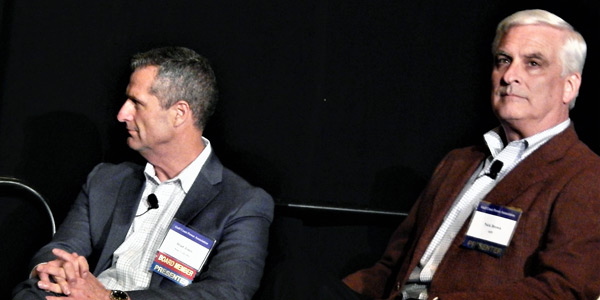By Tom Kleckner
HOUSTON — The CEOs’ roundtable has become one of the top draws at the Gulf Coast Power Association’s Spring Conference, and this year was no different. Bill Magness (ERCOT) moderated an April 19 panel that included John Bear (MISO), Steve Berberich (CAISO), Nick Brown (SPP) and Brad Jones (NYISO). The five discussed the state of wholesale markets, grid operations, implementing federal and state statutes and regulations, and cybersecurity readiness.
“We have renewable portfolio standards by states, tax incentives for wind,” Bear said. “That has a big impact on our marginal costs, especially in Illinois, and that has put a lot of pressure on coal plants and nuclear plants there. Rather than talk about state issues and state subsidies, we’ve got to talk about all the issues together, because they’re colliding. They’re coming to a head.”
Berberich agreed, saying that as CAISO has installed more solar and wind capacity, it needs to find ways to harness their power. “If we don’t use a distributed generating asset in our market, we’re going to have to duplicate them on the central system, and they cost too much,” he said. “As a grid operator, I’m sure we can all agree storage is a valuable resource. It’s the most flexible resource you can get. We have to be concerned about all system costs, because I think system costs are one of these things that can stop decarbonization.”
Distributed generation also was on the mind of Jones, who said if ISOs and RTOs are going to accommodate those resources onto their systems, “We have to chart that path for the aggregators.
“We have to show them what type of generation we need. We have to show them how we price them and how we dispatch them. We have to show these providers how we’ll monitor their performance,” Jones said.
Among the challenges the CEOs share is forecasting variable resources.
“I’ve been fascinated with the success we’ve had in forecasting [wind energy],” Brown said. SPP has integrated 16 GW of wind into its footprint, with penetration levels exceeding 54%. “That success has come from the granular nature of the forecasting. We’re taking multiple data points in each counting. That amount of data is massive, but that’s just the tip. As many have postulated, solar will be the next wind. If you look at our footprint, the solar will be laid over the wind. The next question is, where will it go?”
Jones said NYISO has made progress on the challenge of quantifying rooftop solar. “We’re actually taking real-time data right now off of 10% of the rooftop panels statewide,” he said. “We’re rolling that through a forecasting tool, which looks at each [transmission] zone across the state. We’re having incredible results with that now.”
Asked about the Department of Energy’s recent announcement of a study on renewable energy’s effect on baseload generation, Berberich said, “I’d say it’s a short study. I could probably do it in about an hour.”
“Natural gas took the first bite out of coal and nuclear; that’s not going to change,” he continued. “When you inject zero-cost renewables, it’s going to crush capacity costs. So, there you go. There’s the report.”
Cybersecurity Concerns
Brown addressed the grid’s security, using the military’s drilling with live ammunition as an example.
“We talk about the grid being such a huge national resource and yet, in my view, we’re not really taking any steps to prevent [physical] attacks because of the money involved,” he said. “The concept in many of our states is there’s only so much spare equipment that meets that used-and-useful test. A utility is not going to get recovery on that, which kind of boggles my mind. We’re not, in my view, taking adequate steps to build the infrastructure to be able to respond.”
Community Choice Aggregation
Looking into the future, Berberich said Pacific Gas and Electric could be losing as much as 40% of its load to community choice aggregators, which draws into question the entire utility model. “These aggregators are generally communities, towns, cities and counties that want to procure their own energy and get out from under the incumbent utility,” he said. “Many of them are associated with cleaner, greener energy, but there’s the broader issue here of just choice. Should the utilities be in the retail business? Because all this load is coming off anyway.”






